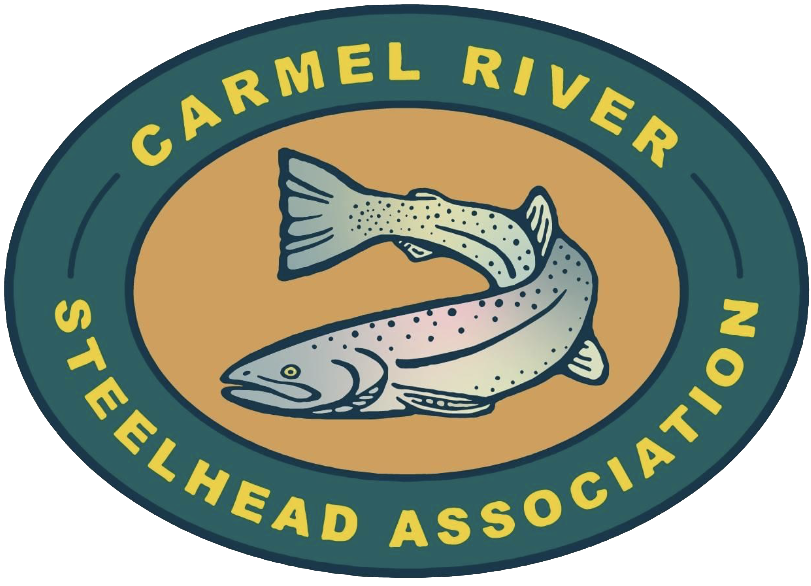While there are many reasons Carmel River Steelhead are endangered, lack of adequate water ranks number one. The Carmel River has been the primary source of water for the Monterey area resulting in over-pumping of the aquifer, thus drying the river. Similarly, local pumping for housing and vineyards results in the drying of most of the river’s tributaries.
With so many people wanting a portion of our limited amount of water, it has been a primary function of CRSA to be an advocate for adequate water for fish. Attending meetings, commenting on environmental documents, protesting excessive water withdrawals, bringing up illegal actions to appropriate bodies as well as illegal actions by public agencies and in general fighting for the rights of fish is a never ending endeavor. Over the years a lot of the benefits for fish have been the result of CRSA actions.
Here are some of the things CRSA has done for Water Advocacy:
2015 Pacific Grove Local Water Project
In July of 2015 Pacific Grove issued a Draft Supplemental EIR for the same project, but now Pacific Grove was proposing to ask for water entitlements from Monterey Peninsula Water Management District (WPWMD) for more water than they would save, thus increasing harm to the river and steelhead.
CRSA and others protested the Supplemental EIR. Our protests were not enough to prevent Pacific Grove certifying the Supplemental EIR, so CRSA had to take further action. While CRSA felt the PGLWP was a good project, by asking for a water entitlement, it was contrary to the Cease and Desist Order.
CRSA met with both the General Manager of Pacific Grove and the attorney for Pacific Grove to persuade them to not seek a water entitlement. When this failed, CRSA and others pressured the State Water Resources Control Board (SWRCB) to put a condition on the loan Pacific Grove wanted for the project.
In the end, the SWRCB authorized Pacific Grove the one percent loan they were seeking, but agreed with CRSA that Water Order 2009-0060 (Cease and Desist Order) prevented Pacific Grove , or any other city, to allow hookups for new or expanded water use until the Cease and Desist Order was complied with. The actual condition was that Pacific Grove could not use the “saved” water for new or increased use until the Director of the SWRCB gave permission.
2014 Cease and Desist Order Extension
In 2009 CRSA was instrumental in the State Water Resources Control Board (SWRCB) issuing Water Order 2009-0060 ordering Cal Am to stop pumping water illegally from the Carmel River by December 31, 2016. Because of that order Cal Am started seriously working on a new water source for the Monterey Peninsula. That source was to be a new desal plant.
Because of numerous reasons that will not to be discussed here, in late 2014 it became apparent the new desal plant would not be ready by December 31, 2016. Cal Am organized a group of stakeholders to meet with the SWRCB to start discussions about extending Water Order 2009-0060.
CRSA was part of that stakeholder group and took the position that the best thing for steelhead would be to stop all illegal pumping and the excessive pumping to maintain water rights. Realizing that it is socially, economically and politically unrealistic for that to happen without a replacement water source, and realizing that even if Cal Am reduced pumping significantly the river would still have problems, the second best thing would be additional mitigation to help the fish during the extension and to help set the stage for recovery when water was no longer over-pumped from the river.
CRSA lobbied and took the lead in advocating for significant additional mitigations. Cal Am agreed to spend up to $2.5 million for additional mitigation if the Cease and Desist Order was extended. Working with Monterey Peninsula Water Management District and Cal Am, CRSA put together a list of mitigation items needed on the Carmel River. With input from National Marine Fisheries Service, California Department of Fish & Wildlife and Cal Am, we determined which projects could obtain a permit and could be completed during the time the extension was to run. Cal Am agreed to the following list of mitigation items and approximate costs:
- Additional spawning gravel injections below Los Padres reservoir ($0.2 million).
- Improvements to the existing upstream fish passage ladder and trap at Los Padres Dam ($0.2 million).
- Installation of a fish screen at the lower outlet pipe on Los Padres Dam ($0.8 million).
- A pit tagging program ($0.8 million).
- A through-reservoir survival study for Los Padres Reservoir ($0.5 million).
Cal Am agreed to a total of $2.5 million. These projects will be done in the order listed and, if some take more money than expected, the last on the list will either be shortened or eliminated.
CRSA believes that when the listed mitigations are implemented, steelhead will be in a better position to recover once water is restored to the river.
2010 Lagoon Notice of Intent to Sue
River lagoons are essential in the life cycles of water dwelling wildlife and in particular steelhead. For years it has been against the law for anyone or any agency to artificially open (breach) a lagoon to the ocean. For years the County of Monterey would artificially breach the Carmel River lagoon whenever they felt it was necessary to protect property from flooding and for years CRSA complained about the practice with no success.
When a lagoon is artificially breached much harm is done to steelhead. Young fish are flushed out to sea before they are acclimated to salt water and habitat for steelhead is reduced as is their food supply. When the County would breach the lagoon, they would usually breach at the south end of the sandbar and straight out. That caused the lagoon to empty faster than at other breaching locations thus worsening the above mentioned problems and insuring future breaches that year would do the same.

In October of 2010, CRSA filed a Notice of Intent to Sue (NOI) which was served on the county for its illegal breaching. Faced with the potential of a lawsuit for “take” under the Endangered Species Act and after several meetings between agency employees and CRSA, the County agreed to obtain all necessary permits, consult with National Marine Fisheries Service, and implement a future project to make breaching unnecessary.
While the County still breaches the lagoon each year under a year-by-year emergency permit, they now are required to breach in a manner that is the least harmful to steelhead. They have to manage the breach, and also close the lagoon in spring to retain as much water as possible for summer habitat.
The regulatory agencies have also notified the County that yearly “emergency breaches” will not be allowed to continue. This has started serious discussions of alternative solutions to breaching. Unfortunately, those solutions will cost a lot of money and are years away, but talks have started.
2009 Water Order 09-60
In 1995, because of a complaint by CRSA and others, the State Water Resources Control Board (SWRCB) issued Water Order 95-10 that basically told Cal Am to diligently implement a new water source to replace the illegal water pumped from the Carmel River. In 2008 CRSA filed another complaint with the SWRCB stating that Water Order 95-10 had not been enforced because after thirteen years there was still illegal pumping occurring at the same rate as before Water Order 95-10. That complaint led to hearings to decide if Cal Am had been responsible and if further actions were necessary.
For multiple weeks, hearings were first held in Monterey and then in Sacramento with CRSA members testifying. In the end it was decided that thirteen years was not “diligent” and the SWRCB issued Water Order 09-60, or what has become known as the Cease and Desist Order.
The actual order had 11 parts that were further broken down into many sub-orders. The main parts were:
- Cal Am must implement a new water source by December 31, 2016 and thereafter only pump its legally permitted water from the Carmel River.
- Cal Am may not provide new water hookups for new or expanded use until it is only pumping legally permitted water.
- Cal Am must immediately reduce total pumping from the Carmel River to 10,978 acre feet annually.
- Any water pumped by way of Aquifer Storage and Recovery must reduce the illegal river pumping at a ratio of one-to-one.
Once again, actions by CRSA helped steelhead by limiting water withdrawals from the Carmel River and thus setting up even further benefits for steelhead.
2008 Aquifer Storage and Recovery II
Between 1982 and 1995 the Monterey Peninsula Water Management District (MPWMD) first filed a permit application and then filed an amended permit application with the State Water Resources Control Board (SWRCB) for a water permit for New San Clemente Dam they were planning to build. Although the voters turned the dam down and it was never built, the SWRCB issued permit 20808 to MPWMD for 29,000 acre feet of water.
A new way to utilize permit 20808 was developed where MPWMD and Cal Am working together would take “excess” water from the Carmel River in the winter and pump it to Seaside and store in the Seaside Ground Water Basin for future use; therefore, aquifer storage and recovery was planned with ASR II being the second phase of the program.
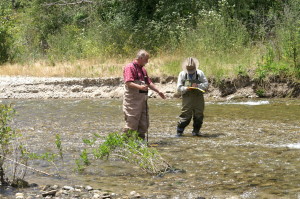
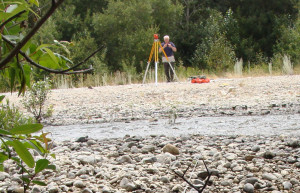
Part of the 29,000 acre feet of water was split off for ASR I (2,426 acre feet) still leaving 26,574acre feet of water in the original permit.
In 2008 MPWMD filed a petition to again change the remaining original permit to allow ASR II to pump an additional 2,900 AF of water at a maximum rate of 8.0 cubic feet per second (cfs).
In 2008 CRSA and National Marine Fisheries Service (NMFS) filed protest against the petition to change the permit. The CRSA protest was because of environmental concerns, mainly because MPWMD wanted to allow pumping in the winter if the river was running over 80 cfs. From walking the river, CRSA strongly suspected that adult steelhead could not migrate upstream
when the river was that low.
To confirm this, CRSA hired Dr. Stacy Li, a retired NMFS biologist, to both help and teach CRSA to perform a Physical Habitat Modeling Platform (PHABSIM) study. Through the efforts of CRSA it was shown that in 2008 on one particular riffle it would take 160 cfs for adult steelhead to migrate upstream.
Using the timely protest as leverage, CRSA negotiated with Cal Am, MPWMD and NMFS to set new pumping standards for the time between the river breaching to the ocean for the first time and the first of May at 120 cfs. After the first of May and until the river breached again, there would be no pumping unless the river was running above 40 cfs.
While this was a great victory for fish it has become even more important because those same flow requirements have been included in water permits issued after ASR II was final.
With the issuing of the permit for ASR II, MPWMD now has three permits one for ASR I of 2,426 acre feet, one for ASR II of 2,900 acre feet and the remainder of the original permit of 23,647 acre feet.
2007 Aquifer Storage and Recovery I
A new way to utilize permit 20808 was developed where MPWMD and Cal Am working together would take “excess” water from the Carmel River in the winter and pump it to Seaside and store in the Seaside Ground Water Basin for future use; therefore, aquifer storage and recovery was planned.
In 2007 MPWMD asked the SWRCB to split the original permit for 29,000 acre feet of water into two permits: one for 2,426 acre feet to be used for what is known as Aquifer Storage and Recovery I (ASR I) and the remaining 26,574 acre feet to be held for future use.
CRSA filed a protest but, unfortunately, the protest letter was filed after the deadline and had no legal standing. Regardless, the SWRCB discussed the CRSA protest with the CRSA board of directors who at the time believed promises were made, however since none were implemented and because the original protest was late, CRSA had no legal remedy.
1995 Water Order 95-10
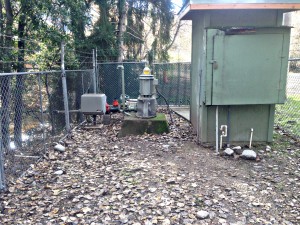
Cal Am Garzas Production Well
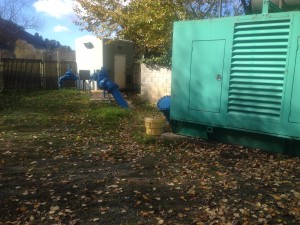
Cal Am Canada Production Well
After almost a year, the SWRCB ruled in our favor and issued Water Order 1995-10 (WO 95-10). This Order had 14 parts which, among other things, told Cal Am it could no longer pump more than 14,106 AF of water, to diligently implement a new water source in order to get down to its legal amount of water and that “Cal-Am shall be responsible for implementing all measures in the ‘Mitigation Program for the District’s Water Allocation Program Environmental Impact Report’ not implemented by the District after June 30, 1996.” In other words, if MPWMD no longer did any or all parts of the Five-year Mitigation Plan, Cal Am would have to do them.
While not part of the actual order, but in the reasoning and discussion of WO 95-10, the SWRCB talks about the MPWMD’s Mitigation Program and states that the program would “continue the Interim Relief Plan.”
Once again, legal action by CRSA helped steelhead on the Carmel River and this action, which resulted in WO 95-10, has been the driving force for mitigation and adequate water for fish since 1995.
1990 Water Allocation EIR
In April of 1990 MPWMD issued the Final Water Allocation EIR which analyzed 5 different proposed water withdrawals from the Carmel River ranging from 16,700 acre-feet (Option V) to 20,500 acre-feet (Option III). The report showed that without mitigation all five proposals would have “Significant Impacts on the Fisheries on the Carmel River.” With mitigation, Option IV (17,500 acre-feet) and Option V (16,700 acre-feet), the impacts to steelhead could be reduced to “Less Than Significant.”
Option I, the option being used at that time, was 18,400 acre-feet. This Option had 7 mitigation measures and still did not bring the impacts to “Less Than Significant. Those mitigation measures were the same ones used to bring the impacts of Options IV and Option V to “Less Than Significant.”
In July of 1990 MPWMD issued a separate Draft Fisheries Mitigation Plan Allocation EIR that was a supplement to the Water Allocation EIR. This was a report in which MPWMD staff modified the proposals in the Water Allocation EIR. The report explained the need for the parts of the future Five-year Mitigation Plan and expanded the concept of the future Five-year Mitigation Program. It is not clear how a separate fisheries mitigation plan fits legally into a public EIR especially as the Draft Fisheries Mitigation Plan Allocation EIR modified some of the agreed to provisions of the Final Water Allocation EIR.
The Final Water Allocation EIR did not mention which option was chosen. That was apparently done by the MPWMD Board of Directors vote on November 5, 1990 where the Board certified the Final Water Allocation EIR and approved the Five-year Mitigation Program.
This was the start of MPWMD’s mitigation program and incorporated the Interim Relief Plans as a part of the program. While the mitigation program was officially the “Five-year Mitigation Program,” at the end of the five-years the MPWMD Board voted to continue the program and has done so every year since.
By providing written comments and protests, CRSA participated significantly in both the Draft and the Final Water Allocation EIR and our input helped provide protection for steelhead.
1988 Interim Relief Plan
In 1988 CRSA filed a complaint with the State Water Resources Control Board (SWRCB) in regards to the environmental damage being done by over-pumping the Carmel River. In the complaint, CRSA offered the following remedies as a solution to the environmental damage:
- Rescue and rearing of fish stranded in the Carmel River.
- Irrigation of riparian vegetation.
- Release of more water from San Clemente Dam.
With the complaint filed, the Monterey Peninsula Water Management District (MPWMD) was given two choices: either develop an Interim Relief Plan (IRP) or have the complaint go to hearing.
Rather than go to a hearing and by negotiating with CRSA, MPWMD adopted the 1998 Interim Relief Plan on September 12, 1988.
For the fish rescue portion, MPWMD agreed to dedicate one half of an aquatic biologist’s time for environmental maintenance at a cost of $ 30,000 annually and, in addition, create a $30,000 contingency fund for dry-year smolt transportation.
A three-part program was recommended to fulfill the rearing portion of the rescue/rearing program.
- Hire a professional aquatic biologist half time.
- Develop an instream rearing program during normal years. The plan was to create ponds (plastic or fiberglass) down-river from the San Clemente filter plant and put stranded fry from the lower river in those ponds. (There were also plans to add feed and nutrients to the river between San Clemente Dam and the Carmel Valley Village.)
- Develop a plan to capture down migrating smolts in dry years when they are prevented from reaching the ocean because of the river going dry.
Of interest related to the rescue/rearing program, the following quote appears on Page 11 of the IRP, “Cal-Am has agreed to dedicate the land subject to limitations on access. Start-up cost would be paid by the CRSA as well as the ongoing cost of feed ($15,000 to $20,000). CRSA would donate labor for maintenance of the rearing program and assist in the rescues.”
As the riparian irrigation portion does not directly impact fish, it is not a part of this recap.
The release of water from San Clemente Dam was to be accomplished by modifying the already existing MOU between Cal Am, the MPWMD, and the California Department of Fish and Game, (now called California Department of Fish and Wildlife or CDFW).
Although CRSA had been rescuing fish for years, the original complaint to the SWRCB and the subsequent IRP was the beginning of the formal rescue and rearing program on the Carmel River.
